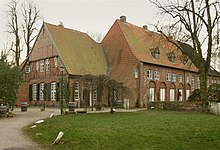Margaretha von Ahlefeldt
Margaretha von Ahlefeldt ( also: Margaretha von Alefelt ) (* 1613 ; † November 1681 in Uetersen ) was a German benefactress and prioress of the Uetersen monastery .
Life
It came from the Wulfshagen house in what is now the Rendsburg-Eckernförde district , formerly the Eckernförde district . According to her will, her parents “ died prematurely in my tough youth ”. Margaretha von Ahlefeldt was the prioress of the Uetersen monastery from 1656 to 1681. She was the successor of Magdalena von Schack († 1656) and was elected head of the monastery on November 11, 1656.
In 1644 she had today's "House of the Prioress" built, a half-timbered gable extension on the old south house of the monastery. There the prioress housed u. a. Kings, Landgraves and Dukes. The monastery was obliged to receive and feed the traveling rulers. The Queen of Denmark, Charlotte Amalie von Hessen-Kassel (1650–1714) , allowed herself to be dined with about 80 subjects twice in 1675 and disappeared from the monastery without much thanks. The monastery clerk Johan Moritzen later calculated the cost of each visit to be almost 60 schillings per person.
Just as the prioress wrote her surname in contrast to all other representatives of her gender, she also had it carved into the supporting beam of her gable, the inscription of which reads: ANNO 1644 THE 24TH MARTI. I HAVE MARGARETA FROM ALEFELT. P (riörin). HAVE THIS GEBAVE BUILT. The initials of a blessing follow: G. (ott) W (olle) B. (ewahren) M. (ein) D. (ach) I. (mmerdar) D. (ir) S. (ei) E. (hre ) For eternity). Today it is the oldest completely preserved building in Uetersen and is due to its high architectural and historical value as a cultural monument under monument protection .
In addition, in 1667 she had the old monastery church, which was badly damaged in the war, rebuilt. The church stalls were erected, the pulpit and the altar decorated with paint and gold leaf . She took care of the organ and built a new choir with the nuns . The church received a new spiral staircase , which has been in the State Museum in Gottorf Castle since 1908 and is exhibited there.
In today's monastery church , too , the voluntarily restored chandelier above the baptismal font bears witness to the work of Margaretha von Ahlefeldt.
She herself acted against the general impoverishment. Her parents, as she wrote in her will, “ had died prematurely in my slow youth and had not bequeathed anything to her ... everything that she would one day would have been acquired through God's mild blessing, diligent supervision and economical housekeeping get on. That is why I also owe it to God in advance of this in honor of God, which can not do better than when it will do good to the poor and needy people, including churches and their servants ... "
During her lifetime she had a burial chamber built in a corner under the choir and was buried in her burial chamber in November 1681, as she wished in the will, " without lavish pomp ... in the evening with torches and good music ". Seventy years later, when they wanted to build over the old monastery church, the burial chamber was always in the way of planning. Nobody wanted to remove this chamber, because nobody knew exactly who was resting there. So the chamber, collapsing, remained in place for more years. It was not until 1813 that the burial chamber was demolished and the copper coffin recovered on behalf of the prioress Dorothea Catharina von Ahlefeldt († 1814). The inscription was noted with amazement, and the coffin was buried in the central aisle of today's monastery church. To date, the grave plate has not been inscribed and the grave site is only known to a few.
literature
- Johann Friedrich Camerer : Mixed historical-political news in letters from some strange areas of the duchies Schleßwig and Hollstein, their natural history and other rare antiquities (Flensburg and Leipzig 1758–1762)
- Wilhelm Ehlers: History and folklore of the Pinneberg district (Verlag JW Groth Elmshorn 1922)
- Hans Ferdinand Bubbe : Attempt of a chronicle of the city and the monastery Uetersen Volume 1 Chapter I Pages 39 and 56 (CDC Heydorns Verlag Uetersen 1932)
- Erwin Freytag : List of provosts and priories at the Cistercian nunnery and later Adlid monastery in Uetersen , yearbook for the Pinneberg district (Beig Verlag Pinneberg 1970)
- Doris Meyn: List of provosts and priories of the Uetersen monastery up to the end of the 17th century. In: Journal of the Society for Schleswig-Holstein History . Vol. 101, 1976, pp. 73-116, ( digitized version ).
- Elsa Plath-Langheinrich : The monastery at Uetersten End (CDC Heydorns Verlag 2008)
- Elsa Plath-Langheinrich: Uetersen Monastery in Holstein ( Wachholtz Verlag 2009)
- Maike Schablinski: Ahlefeldt, Margaretha von . In: The Uetersen Lexicon. Schmidt & Klaunig, Kiel 2012, ISBN 978-388312-421-6 , pp. 15-19
Individual evidence
- ^ Lothar Mosler: Uetersen, History and Stories 1234–1984 . Pages 15–16.
| personal data | |
|---|---|
| SURNAME | Ahlefeldt, Margaretha von |
| ALTERNATIVE NAMES | Alefelt, Margaretha von |
| BRIEF DESCRIPTION | German benefactress and prioress of the Uetersen monastery |
| DATE OF BIRTH | 1613 |
| DATE OF DEATH | November 1681 |
| Place of death | Uetersen |

